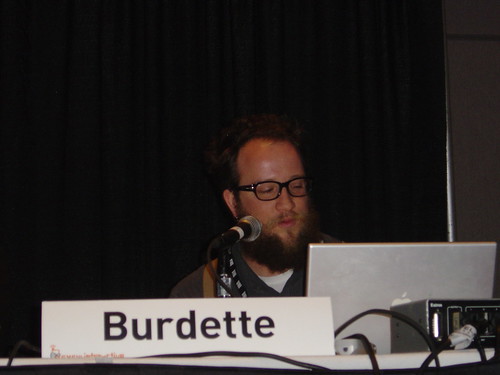SXSWi 2009: Is Aristotle on Twitter?
Last March I went to SXSWi 2009. I posted the notes from two of the days, but conference exhaustion got in the way of me posting the notes from the last three days. After much delay, here they are.
Is Aristotle on Twitter?
Room B
Tuesday, March 17th
10:00 am – 11:00 am
We introduce a framework for understanding information overload by reflecting on and updating ancient communicative traditions. Aristotle was an information maven and Cicero a communication connoisseur. These classical communicators designed their speeches around five principles: invention, style, arrangement, memory, and delivery. Contemporary communicators build on this tradition with Web-based technologies.
Trish Roberts-Miller: Assoc Professor, University of Texas at Austin
Jillian Sayre: University of Texas at Austin
John Jones: University of Texas at Austin
Jim Brown: University of Texas at Austin
William Burdette: Asst Instructor, University of Texas at Austin
William Burdette:
Is Aristotle on Twitter? Yes. He has four followers (including me)
We’re going to monitor the back channel.
Twitter fatigue? This is a short hand for new media technologies.
Rhetoric does not equal Lies It’s verbal persuasion.
The Canons of Rhetoric Invention Arrangement Style Memory Delivery
Trish Roberts-Miller:
Invention:
Rhetoric has been viewed as an arrow hitting the audience. Getting people to do what you want.
In politics and ethics, you cannot argue from first principles. You have to argue from consensus, but this is bad as well.
Wisdom is very important. Take big abstractions and put it together in a specifc case. We argue from the contingent.
We should be discerning to see whether a speaker has good ethos. What did they say in the past? Were they right? Did it work alright?
This woman is losing me. She isn’t making it relate to real life and the slides have NOTHING to do with what she’s talking about.
We try to figure out if someone is a GOOD person.
Four kinds of popular Twitterers:
Fame: Britney Spears People feel like they see the real person.
Ethos: Wil Wheaton They give ethos.
Headline Feeds: CNN
Give Good URL: Discerning at judging other sources
John Jones:
Arrangement
The ordering of elements in text. Say something before, set the case, refute arguments and restate the case.
The audience can follow the order or get lost.
He’s going WAY too fast. :(
Print arrangement suggests a path. Spacial
Oral arrangement has temporality.
Authors have less control of how readers do with thier text.
THIS GUY SUCKS!! Kathy Sierra needs to smack him.
William Burdette:
Style
Impediment to style. Inability to oscillate
We are not at a place where we value looking at, not through.
Pitts is looking AT Twitter, not through it.
Bust of Aristotle: At: it’s Aristotle Through: It’s a photo of a bust of a bronze
We need style because of defective audience.
Facts come first. Style comes after the fact. Natural speech feel real and artificiality is not. Naturalness is persuasive. Style to be good, must be clear. People are struck by “what is out of the way.” Unfamiliar speech can make them pay attention. Clearness is secured by familiar words. Unfamiliar words is secured by elevation, poetry.
Style is oscillating between familiar and unfamiliar. If you always retweet, peole look through you. If you are always posting what you are doing people are looking at you.
Jillian Sayre:
Memory
Memory is a communication skill. It was the place to store up good ideas until you can use them.
We’ve found other ways to remember things.
Memory has been become prothetic. It is a materialization of memory. It now has a spatial dimension.
Is there death in the digital age? Is there memory or just virtualization?
Jim Brown:
Delivery
Delivery is the regulation of the voice based on the audience. Studying delivery in a textbook is a waste of time.
HBO series Rome Newsreader robotic movement
Obama is clearly the a great rhetoric person. Beyonce is teaching how to move their bodies, but how to deliver meaning with their bodies. Obama meets Beyonce
EXCELLENT
Question: In your minds, who are the best sources of URL?
Trish Roberts-Miller:
It might be a colleague who you trust. People in rhetoric in both sides. I can’t say a single person.
John Jones:
I suspect it’s a really individual thing. There is too much info out there. When your friends ALL link to the same thing, then you can look at it.
Jim Brown:
It’s audience specific, but how do you determine your audience?
Question: Can you recommend something to teach Rhetoric for Dummies?
William Burdette:
You have 2000 years of works to choice from. Do a Google book search for Rhetorical, you can find lots of books available for free online.
Jim Brown:
Don’t pick up Aristotle’s Rhetoric
John Jones:
If you’re just interested in argumentation: Thank you for arguing.
The Economics of Richard Landam?!
Okay, this guy just redeemed himself. Should have repeated the book titles twice, however…
Trish Roberts-Miller:
Rhetoric is a kinetic learning thing.
John Jones:
This guy is sucking. He’s going TOO fast.
Twitter allows a temporal arrangement. Readers can read in whatever order they choose. It’s different than oral and print. The stream matters, not individual posts.
Man, that was like watching an episode of ZERO PUNCTUATION!!
John Jones:
Twitter has ALWAYS been happening. There hasn’t been a rhetoric developed for just having a conversation because there has never been a great way to capture a conversation. You could record it, but it was difficult to scan. Twitter has taken a conversation into the text world, so NOW we can study it.
If something is left over, people are going to find it interesting.
Question: How can you get people to look at AND through? How do we get them to just look?
William Burdette:
The reason I love Landam’s word of ossiclation is because it scans between the two. It’s important why it’s necessary.
Jim Brown:
It’s an argument for the liberal model of education. You need a broad approach to education so you can communication.
Trish Roberts-Miller:
You can always separate form and content. Form and content aren’t completely split. Look for parallelism that comes together. The medium is the message.
Question: You get public and private content that are mixed in one space. What is the effect of that on the communicator and audience?
Trish Roberts-Miller:
The Social. There is a blending of the two. At its best it reminds us that the personal is the political. At its worst is that it convinces us that the personal is the political.
Jim Brown:
Who is the audience? If you’re annoyed by my tweet, it wasn’t for you.
John Jones:
When you can read minds, you can suddenly read EVERYBODY’S mind at the same time. You don’t have to read everyone’s tweets.
Question: Many people use Twitter for the FACT. What about the style?
William Burdette:
A lot of what happens on Twitter is LOOK AT ME. If you start to look through, then you are driving the swarm.
John Jones:
Style is inauthentic, but then at the same time you need to be natural to be believed.
Trish Roberts-Miller:
It’s very difficult to be playful with language with 140 characters. We think that plain style is more authentic.
John Jones:
The best way to get people moved to emotion, is to fake emotion. If they catch you, then you are lost. You must COUNTERFEIT emotion.
When you teach people the tools of rhetoric, then you immunize them against it.



I have preemptively smacked myself, just in case I never run into Kathy Sierra. :)
Re the books: The second title was ‘The Economics of Attention’ by Richard Lanham. You can find an excerpt of Chapter 2 here, and a version of Chapter 3 can be read here.
Cheers,
John
Comment by John Jones — 6/1/2009 @ 11:20 am
John,
You get extra kudos for finding this and posting links to the books.
Thanks,
Laura
Comment by Laura Moncur — 6/1/2009 @ 12:18 pm